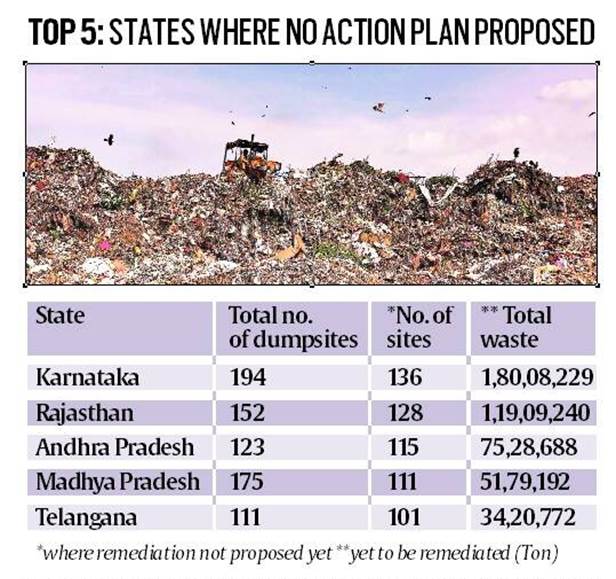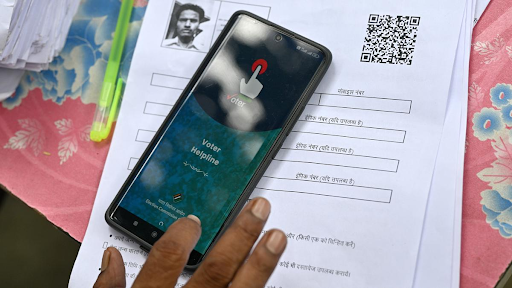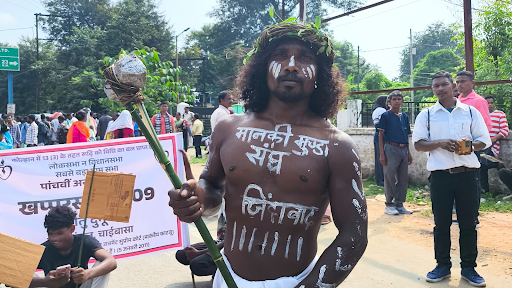Description

Copyright infringement not intended
In News
- According to the Union Housing and Urban Affairs Ministry’s Swachh Bharat Mission-Urban (SBM-U) dashboard, 5 states account for more than half of the 1,080 “legacy landfill sites” for which authorities are yet to propose remediation plans under the Swachh Bharat Mission-Urban 2.0.
- “Legacy” dump sites are the old waste at landfill sites that have remained dumped for more than three months.
- Of 1,080 sites for which remediation was yet to be proposed, 591 were in five states:
- Karnataka (136)
- Rajasthan (128)
- Andhra Pradesh (115
- Madhya Pradesh (111)
- Telangana (101)
- In Delhi, about 84% of the 2.80 crore tonnes of legacy waste is yet to be remediated.
- Swachh Bharat Mission-Urban 2.0 has the target of creating “garbage-free cities” and 100% remediation of all legacy landfills by 2026.
- Under the mission, municipalities are required to submit action plans for the bio-remediation of legacy landfills.
- Depending on the composition of the waste, it will be divided into refused derived fuel (RDF) for waste-to-energy plants, construction and demolition (C&D) waste for recycling and bio-soil that can be used to fill gaps in road construction.
- After clearing the dump sites, municipalities are required to firm up plans for alternative use of the land.
Swachh Bharat Mission
- Swachh Bharat Mission (SBM) is a country-wide campaign initiated by the Government of India in 2014 to eliminate open defecation and improve solid waste management.
- It is a restructured version of the Nirmal Bharat Abhiyan launched in 2009.
- Phase 1 of the Swachh Bharat Mission lasted till October 2019.
- Phase 2 is being implemented between 2020–21 and 2024–25.
- The mission aimed to achieve an "open-defecation-free" (ODF) India by 2 October 2019, the 150th anniversary of the birth of Mahatma Gandhi through the construction of toilets.
- The objectives of the first phase of the mission:
- Eradication of manual scavenging.
- Generating awareness and bringing about behaviour change regarding sanitation practices.
- Building capacity at the local level.
- The second phase of the mission aims to sustain the open defecation-free status and improve the management of solid and liquid waste, while also working to improve the lives of sanitation workers.
- Under the scheme, the Government provides subsidies for constructing toilets, waste management structures, and awareness campaigns to bring behavior change.
- The campaign is financed by the Government of India and state governments.
- The mission is split into two: Rural and Urban.
- In rural areas "SBM - Gramin" is financed and monitored through the Ministry of Jal Shakti.
- In Urban areas "SBM - urban" is overseen by the Ministry of Housing and Urban Affairs.
.jpg)
Landfill Sites
- Land filling is the oldest and most common form of waste disposal. A landfill site is a site for the disposal of waste materials.
- Waste Management System includes Collection, Segregation, Transportation, Processing and Disposal of waste.
- Waste is classified into Several Categories based on Source and type of waste. These include;
- Domestic waste
- Municipal waste
- Commercial waste
- Institutional waste
- Construction and Demolition waste
- Hazardous waste and Sewage waste
Concerns
- Absence of Segregation of waste at source.
- Landfill often Catches fire due to the release of Methane by Waste.
- Due to a lack of proper treatment facilities, by-products released during decomposition seep into Groundwater and pollute it.
- It is unfair to Citizens of that area to export the City’s garbage to their locality.
- Asthma, Tuberculosis, and Skin diseases are Some Common Health Problems among the rag Pickers
- Dumping is done in landfills without following scientific methods of disposal.
- Improper waste management causes environmental hazards like climate change, pollution, and the spread of odours and diseases.
- Affect human and animal health and result in economic, environmental and biological losses.
- Lack of funds for local bodies.
- Lack of technical expertise.
Steps need to be taken
- Garbage needs to be Reduced, Reused, and Recycled.
- Improvements in Waste Segregation, Collection and Transportation.
- Maximum recycling and Treatment of waste must be done at the local level.
- Involve informal Sector/waste pickers and Citizen groups to Collect and Segregated waste, under a door-to-door Collection System.
- Reduces the quantity of waste and recovers Products of economic value.
- Decentralized waste treatment options Such as Composting units, biogas Plants, waste to-energy Plants.
- Promote the Concept of Zero Waste to minimize the use of resources and maximize benefits.
- Prepare an integrated Solid waste management Plan for the Whole City.
- Educate Citizens about waste Segregation and make them active Stakeholders in waste management.
- Reaching out to School Students to generate awareness about Sustainable waste management
- Strengthening municipal governance, improving waste management and developing regulations within Urban Local Bodies for improving waste segregation.
- Promote the Principle of 5R: Reduce, Reuse, Recover, Recycle, Re-manufacture.
- Set up regional sanitary landfill to reduce land requirements.
- Create an Adequate Funding Mechanism to Implement waste Regulations.
- Capacity-building of local Bodies.
- Development and setting up of infrastructure for Segregation, Collection, Storage, and transportation of waste.
- Regular monitoring for ensuring the safety and health of workers involved in dismantling and recycling.
- Creating Green Belt around Landfill Sites.
.jpg)
https://indianexpress.com/article/india/over-50-landfill-sites-in-5-states-no-remedial-plans-8310034/
https://t.me/+hJqMV1O0se03Njk9






.jpg)







